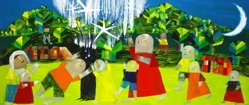One of the things we like to do at CANVAS is to publish short environmental stories (either as books or on our website or both), not only for the lessons they carry, but also as a medium for showcasing works by Filipino artists.
We have two such stories on our website now - "The Hummingbird" interpreted by Plet Bolipata and "The King and the Royal Trees" which was illustrated by Ivee Olivares-Mellor.
Below is another story, "The Star Thrower," for which we are still looking for an appropriate artist.
Many of you may have already seen this story, or a version of it, as it is popular on the Web. It's not clear who wrote it, but it is often most attributed to anthropologist Loren Eiseley. But his original tale is told differently and the message is less upbeat.
Anyways, if you could recommend or suggest a good Filipino/Filipina artist, we'd be happy to hear it.
==================================
THE STAR THROWER
One day, thousands of starfish had washed ashore along a beach that a man was walking upon. As he looked down the beach, he saw a human figure moving like a dancer.
When he got closer, he saw that it was a little girl and she wasn't dancing. Instead she was reaching down to the shore, picking up starfish and very gently throwing it into the ocean.
He called out, "Good morning! What are you doing?" The little girl paused, looked up and replied "Throwing starfish into the ocean so they won’t die."
"Don't bother, dear," the man said, "There are too many starfish. It won't make a difference."
The little girl listened politely. Then she bent down, picked up another starfish and threw it into the sea, past the breaking waves.
She then looked up and the man, smiled and said, "Well, it made a difference for that one!"
Saturday, October 27, 2007
Subscribe to:
Post Comments (Atom)





2 comments:
Hello! I do commend your project, but it is misleading to say that "it's not clear" who wrote The Star Thrower. It is definitely Loren Eiseley. His essay has been popular ever since he wrote it and has been adapted many times over, to a point beyond recognition.
The full essay is part of his book, The Unexpected Universe (1969). You can download an abridged version as reference.
One essential element missing in many "new" versions is the fact that the observer is changed by the encounter and, in the end, decides also to become another star thrower.
The "original tale", as you put it, has a much more amazing message, about man's compassion in the face a of cold, brutal universe. You have to realize that Eiseley was a scientist and he meditated upon the universe and science unlike most scientists of his day.
Unfortunately, his writing style won't appeal to the reader of today, with it's slow, deliberate sentences and large, ponderous ideas. But I feel it's still worth the effort to read where these "new" and "upbeat" versions came from.
Thanks for the comment.
What we often wonder about is how one determines when a particular story is written by a person, and not something merely inspired by another person's writing (which we think is how our version of The Star Thrower should be attributed to Eiseley).
If you put them side by side, after all, the difference between the two in tone, style and obviously length is very clear.
Or to use another example, if we were to look at the movie "Snow White," at what point did it become totally attributable to Disney as a story that was inspired by the Brothers Grimm? :-)
Post a Comment